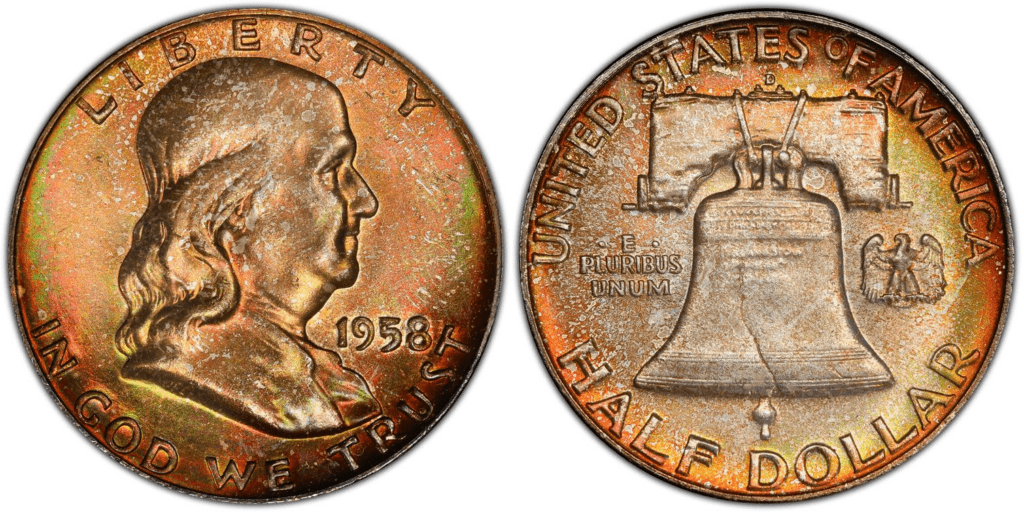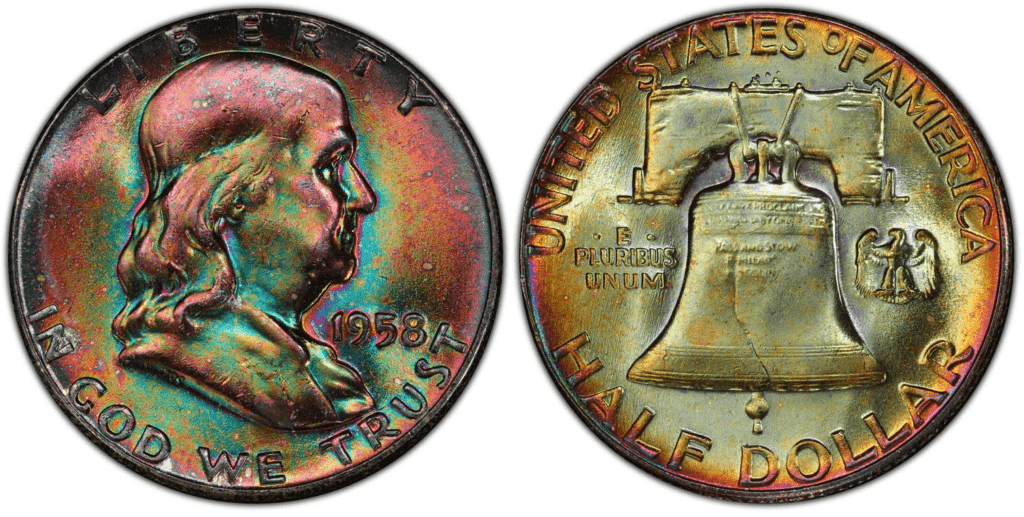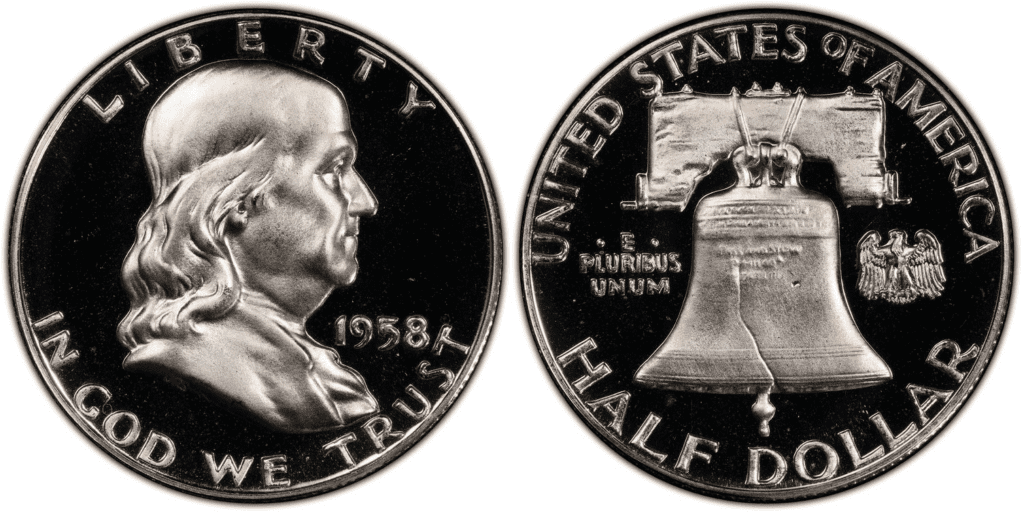What Is the 1958 Franklin Half Dollar Made Of?
The 1958 Franklin Half Dollar is produced in 90 percent silver and 10 percent copper. The exact composition was used for the fifty-cent piece since the U.S. Mint struck it from 1948 to 1963.
The Franklin fifty-cent coin was struck at the mints in Denver and Philadelphia with a reeded edge. It was struck continually until 1963. Its specifications also include the following:
- Value – 50 cents
- Diameter – 31.61 mm
- Mass – 12.50 g
In January 1948, Franklin was put in the cent because of the idea of Mint Director Nellie Tayloe Ross. She instructed John R. Sinnock to design the coin, later completed by his successor, Gilroy Roberts.
Ross was primarily inspired to put Franklin on the coin by the proverb in Franklin’s “A penny saved is twopence dear”. Although the Commission of Fine Arts disliked the design because of the small eagle and believed that the Liberty Bell’s crack could lead to jokes and ridicule, the coin was still released in circulation.
Being larger and of silver, many coin collectors find the fifty-cent much better for producing an impressive effect. Of the 482 million Franklin fifty-cent coins struck for circulation and proof, there were about 29 million coins made in 1958 of the half dollar.

The obverse design of the Franklin fifty-cent coin features Founding Father Benjamin Franklin. As shown in the image above, the following are the included inscriptions of the coin:
- LIBERTY
- IN GOD WE TRUST
- 1958
The reverse side, on the other hand, shows the Liberty Bell with the following inscriptions:
- UNITED STATES OF AMERICA
- HALF DOLLAR
- E PLURIBUS UNUM
- Small eagle – positioned at the right side of the bell
At first, there was limited demand for the Franklin half-dollar coin because of the glut of Walking Liberty halves. There was not even demand for the coin in 1955 and 1956, resulting in no coins being struck in Denver. When the economic conditions improved in 1957, the demand for the fifty-cent began to rise. Five years later, greater demand increased, and there was even a significant coin shortage in 1964.
1958 Franklin Half Dollar Varieties
The 1958 Franklin fifty-cent coins were made in at least three varieties: 1958-D, 1958-P, and 1958 Proof. While these varieties were available, there were also some half dollar coins produced with minting errors.
A complete set of Franklin halves consist of 35 varying business strikes and 14 different proofs. Most collectors are basing their collections on date and mint. Those who can afford it are after date-and-mint sets in MS-65 and above. Others are also collecting high-grade proof Franklins with deep cameo contrast.
Let’s take a look at the description of these varieties and coin errors below:
1958-D Franklin Half Dollar
Year of minting: 1948 – 1963
Mint Mark: D
Place of minting: Denver
Quantity produced: 23,962,412
Face Value: $0.50 (fifty cents)
Price: $0.50 to $25 (or more)
Mass: 2.50 grams
Edge: Reeded
Designer: John R. Sinnock/John Frederick Lewis
Composition: 90% Silver, 10% Copper
Diameter: 30 mm
Thickness: 1.8 mm

photo source: PCGS
The 1958-D Franklin half dollar mintage is over 23 million. Depending on its condition and rarity, the fifty-cent coin can be sold at a price ranging from $0.50 to $25.
1958-P Franklin Half Dollar
Year of minting: 1948 – 1963
Mint Mark: No mint mark
Place of minting: Philadelphia
Quantity produced: 4,000,000
Face Value: $0.50 (fifty cents)
Price: $0.50 to $18 (or more)
Mass: 2.50 grams
Edge: Reeded
Designer: John R. Sinnock/John Frederick Lewis
Composition: 90% Silver, 10% Copper
Diameter: 30 mm
Thickness: 1.8 mm

photo source: PCGS
The 1958 Philadelphia Franklin half-dollar coins were modified in 1958 and 1959. About 5 percent to 10 percent of these coinage is Type II (which means new). The coins were struck from dies previously used to strike the 1958 proofs.
While there was a mass production of about 4 million of the fifty-cent coin, if you are to sell these, you can put a price tag between $0.50 to $18.
1958-P Franklin Half Dollar (Proof)
Year of minting: 1948 – 1963
Mint Mark: No mint mark
Place of minting: Philadelphia
Quantity produced: 875,652
Face Value: $0.50 (fifty cents)
Price: $0.50 to $47 (or more)
Mass: 2.50 grams
Edge: Reeded
Designer: John R. Sinnock/John Frederick Lewis
Composition: 90% Silver, 10% Copper
Diameter: 30 mm
Thickness: 1.8 mm

photo source: PCGS
Franklin Half Dollar Type I features four visible feathers to the left of the perch, while Type II pictures three feathers. In 1956, Type I reverse was used on both circulation and Proofs, while Type II was used only on Proofs. You can find 1958-proof half-dollar coins sold from 50 cents to $47.
1958 Franklin Half Dollar Errors
As mentioned, there were about 29 million Franklin half dollars produced in 1958. Thousands of coins are produced each day, with the die hitting a lot of planchets in just a matter of minutes. Due to wear and tear, mechanical errors, and sometimes, human errors, 1958 50-cent coins received errors in minting.
There are different types of coin errors. These are some of them:
- Blank planchet
- Clipped or folded planchet
- Lamination error
- Cladding flaw
- Doubled die
- Die cracks
- Broadstrike
- Off-center strike
- Weak strike
While coin errors are definitely something that the US Mint doesn’t want to happen, many coin collectors love to have them on their shelves; for one, coin errors are unique, and their appearance makes them look special among other collections.
How Much Is 1958 Franklin Half Dollar Worth Today?
The 1958 Franklin halves’ face value is $0.50. As it is made of 90% silver and 10% copper, its melt value is based on the latest price of the metals and the specifications.
At the current price, the 1948-1963 silver Franklin half a dollar’s approximate melting value is $8.1269. As this is just an approximation, the melting value will vary according to the prices of the silver and copper metals in the market.
The chart below shows you the different values of the Franklin fifty-cent:
| Coin | Condition | Grade | Mintage | Value |
| 1958 D Franklin half dollar | Circulated/mint | Not graded | 23,962,412 | $0.50 to $25.00 |
| 1958 D Franklin half dollar | Uncirculated/mint | MS-65 | 23,962,412 | $24 to $360 |
| 1958 D Franklin half dollar | Uncirculated/mint | MS-66 | 23,962,412 | $48 to $264 |
| 1958 D Franklin half dollar | Uncirculated/mint | MS-67 | 23,962,412 | $300 to $1939 |
| 1958 P Franklin half dollar | Circulated/mint | Not graded | 4,000,000 | $0.50 to $18.00
|
| 1958 P Franklin half dollar | Uncirculated/mint | MS-65 | 4,000,000 | $31 to $192 |
| 1958 P Franklin half dollar | Uncirculated/mint | MS-66 | 4,000,000 | $41 to $99 |
| 1958 P Franklin half dollar | Uncirculated/mint | MS-67 | 4,000,000 | $228 to $360 |
| 1958 P Franklin half dollar (Proof) | Uncirculated/proof | Not graded | 3,028,244 | $0.50 to $47.00
|
| 1958 P Franklin half dollar (Proof) | Uncirculated/proof | PR-67 | 3,028,244 | $51 to $105 |
| 1958 P Franklin half dollar (Proof) | Uncirculated/proof | PR-68 | 3,028,244 | $65 to $187 |
| 1958 P Franklin half dollar (Proof) | Uncirculated/proof | PR-69 | 3,028,244 | $480 to $1,035 |
As you can see, some 1958 half dollar coins are just so valuable that they reach a price tag as high as thousands of dollars. To further give you an idea, you should note the auction record of each variety.
For example, did you know that in September 2018, a 1958 P half-dollar coin was sold for $129,250? That’s a lot of money for a coin with a face value of $0.50. Legend Rare Coin Auctions sold the coin with a coin grade of MS67+FBL.
For the 1958 D half dollar, the auction record is $32,900. It was a coin with a grade of MS67+FBL as well. Finally, for the 1958 proof half dollar, the auction record is $32,900.
How Does The Grading System Work?
The Sheldon Scale is used by numismatists to provide a numerical value to coins. The Sheldon Scale goes from poor (P-1) to perfect mint state (P-1) (MS-70). Coins were originally evaluated using words to reflect their condition (Good, Fair, Excellent, Etc.). Unfortunately, coin collectors and dealers had different ideas about what each of these terms represent.
Professional numismatists joined together in the 1970s and established CoinGrading standards. These numismatists now assign grades at key places on the seventy-point scale, using the most regularly utilized numeric points in conjunction with the original adjective grade. The following are the most common coin grades:
-
-
- (P-1) Poor – Indistinguishable and probably damaged; if used, must have a date and mintmark; otherwise, rather battered.
- (FR-2) Fair – Nearly smooth, but without the damage that a coin graded Poor often possesses. The coin must have enough detail to be identified.
- (G-4) Fair – Inscriptions have merged into the rims in some areas, and important elements have been mostly erased.
- (VG-8) Very Good- A little weathered, but all of the primary design elements are visible, albeit faintly. There is little if any, central detail left.
- (F-12) Good – The item is very worn, yet the wear is even, and the overall design details stand out clearly. Rims are almost completely isolated from the field.
- (VF-20) Very Fine – Moderately weathered, with some finer features still visible. The motto or all letters of LIBERTY are readable. Both sides of the coin have entire rims that are separated from the field.
- (EF-40) Extremely Fine – Gently used; all gadgets are visible, and the most important ones are bold. The finer details are bold and clear, however, light wear may be seen.
- (AU-50) Uncirculated – Slight evidence of wear on the coin’s design’s high points; may have contact marks; eye appeal should be adequate.
- (AU-58) Uncirculated Choice – Slight traces of wear, no severe contact marks, almost full mint shine, and great eye appeal.
- (MS-60) Mint State Basal – Strictly uncirculated; no indication of wear on the coin’s highest points, but an unsightly coin with reduced luster, visible contact marks, hairlines, and other flaws.
- (MS-63) Mint State Acceptable – Uncirculated, but with contact scratches and nicks, little reduced shine, but otherwise appealing appearance. The strike is weak to average.
- (MS-65) Mint State Choice – Uncirculated with great mint shine, very little contact blemishes, and exceptional eye appeal. The strike is unusually severe.
- (MS-68) Mint State Premium Quality – Uncirculated with superb luster, no obvious contact marks to the naked eye, and exceptional eye appeal. The strike is quick and appealing.
- (MS-69) Almost Perfect Mint State – Uncirculated with perfect brilliance, a sharp and appealing strike, and extremely good eye appeal. A near-perfect coin with minor imperfections in the planchet, strike, and contact markings (seen only under 8x magnification).
- (MS-70) Mint State Perfect – Under 8x magnification, there are no tiny imperfections discernible; the strike is crisp, and the coin is perfectly centered on a beautiful planchet. Rarely seen on a coin, this coin is bright and whole, with original luster and exceptional eye appeal.
-
Where To Buy Or Sell 1958 Franklin Half Dollar?
Currently, in circulated condition, the 1958 Benjamin Franklin Half Dollar is worth between $9 and $11.50. But you can find a 1958-D Franklin fifty-cent on the open market, and its price value is pristine and can be sold for as much as $1,050.
You can find a good kind of Franklin Half Dollar on eBay or Amazon. You can explore what’s on sale and find the rarities of your collection. There are a lot of assorted varieties you can find, but they come in different conditions and prices. If you’re into online sales, list your Franklin fifty-cent on these sites too. A lot of potentially good buyers are usually on the lookout online.
Aside from that, you can also find some coin shops that offer you a good price for your fifty-cent coin (either you buy or sell). Some pawn shops, antique stores, and auction houses are your go-to places.
If you also like some experts’ advice on where to find and sell your coins, consulting the PCGS or NGC can help.
FAQs
What is the highest grade of the 1958 Half Dollar?
The MS65 (Mint State 65) is the highest grade of the 1958 Franklin Half Dollar.
Is the 1958 Franklin Half Dollar with errors worth $5000?
No. As of now, the Franklin halves with errors are approximately priced between $12 and $4000. However, there might be error coins of Franklin half dollar in the future that could be worth more than $5,000.
How can I tell if my 1958 Franklin half dollars are valuable?
You can assess the amount of wear to the surfaces of the coin to determine the grading category. Aside from that, the 1958-P issue is notable for its lowest mintage (5th lowest mintage year of the strike series). The lower the mintage number, the more valuable it becomes, which usually attracts a collector’s attention.



